Why Disclose Affiliate Links?
As a blogger and an affiliate marketer you might have asked yourself this question, “Do I have to disclose affiliate links?” You definitely do and here are two main reasons for this. Firstly, according to the Federal Trade Commission, a US agency that aims at protecting consumers, you’re legally required to disclose any compensation you get in return for your activities. If you don’t heed the guidelines and keep your affiliate relationships secret, you may get into legal trouble.
Besides, many affiliate programs have their own requirements as far as affiliate disclosures are concerned. So, make sure you understand and follow them. For example, The Amazon Affiliate program requires using a specific sentence in the affiliate disclaimer.
Secondly, affiliate relationships are based on trust and you shouldn’t keep your audience in the dark about them, no matter how tempting it is. There is a wide-spread belief that if you leave your affiliate relationships out, you will avoid the risk of losing a certain part of your audience.
However, it’s usually quite the opposite. Many Internet users are tech-savvy enough to detect an affiliate link and will understand that you’re earning from promoting the product. So, this lie of omission can destroy the rapport with your audience you’ve worked so hard to establish.
Affiliate Links Disclosure Tips
There is a set of rules on how to disclose affiliate links so that they comply with the FTC disclosure guidelines. One of the main points repeated through the FTC guidelines is that your affiliate disclosure must be clear and conspicuous to a reasonable consumer.
Now, we’ll break down what it means and what exactly you need to do to meet the requirements of the FTC.
Make It Visible
Make sure your affiliate disclaimer is clearly seen by your readers and hard to miss. If you don’t, it may look as if you’re not really trying to be transparent with your audience and it may undermine trust. To make a disclosure visible:
- Place it on every page with affiliate links.
- Don’t limit disclosures to the ones placed on your profile, the About or Privacy Policy page.
- Don’t style disclosures to be less conspicuous by using small font sizes or pale colors. Make sure they stand out and can be easily seen.
- Embed disclosures on every platform where you run affiliate marketing campaigns.
- Don’t hide your disclosure in the places where users are not likely to see them, for example, in the footer or at the bottom of the post.
- Don’t make users scroll down or click to read your disclaimer.
- Avoid placing affiliate disclosures in sidebars as mobile users may fail to see them.
Be clear and transparent
The form and the language of the affiliate disclaimer aren’t set in stone and there isn’t a universal affiliate links disclosure template. The main condition is to make your paid relationships clear to the audience. In other words, you need to make sure readers understand what you’re trying to tell them.
Here are some tips to help you create an easy-to-understand and FTC-compliant affiliate disclosure:
- Write your affiliate disclosure in a simple and plain language.
- Avoid using niche-specific terms such as affiliate links, PPC, CPA, etc. Your audience may not know the terms and complicated language can put them off. Besides, this doesn’t make your message transparent and so, doesn’t meet the requirements of the FTC.
- Keep it short.
- Use such words as commission and compensation to make your readers instantly understand that you’re getting paid for promoting affiliate links.
- The disclaimer should be in the same language as the main piece of content in which you embed affiliate links.
Use Your Own Voice
When creating an affiliate disclaimer, don’t be a copycat and avoid using other people’s affiliate disclaimers. Create your own and make sure it resonates with your audience.
You should use the disclaimer as another chance to communicate with your readers and build trust. For this, assure them that you’re only promoting the products and services you’ve tried and can vouch for.
It’s also vital not to sing praises to products you don’t like or which are of bad quality. Also, point it out that your commission will not result in any extra cost for your audience, but you’ll appreciate their support.
To make the process of creating disclaimers and embedding them on your website hassle-free, you can use affiliate disclosure generator tools such as the Disclaimer Generator by PrivacyPolicies, or the one by TermsFeed.
Affiliate Link Disclosure Examples
Now, let’s take a close look at how some well-known travel bloggers disclose affiliate links on their websites.
Lili’s Travel Plans
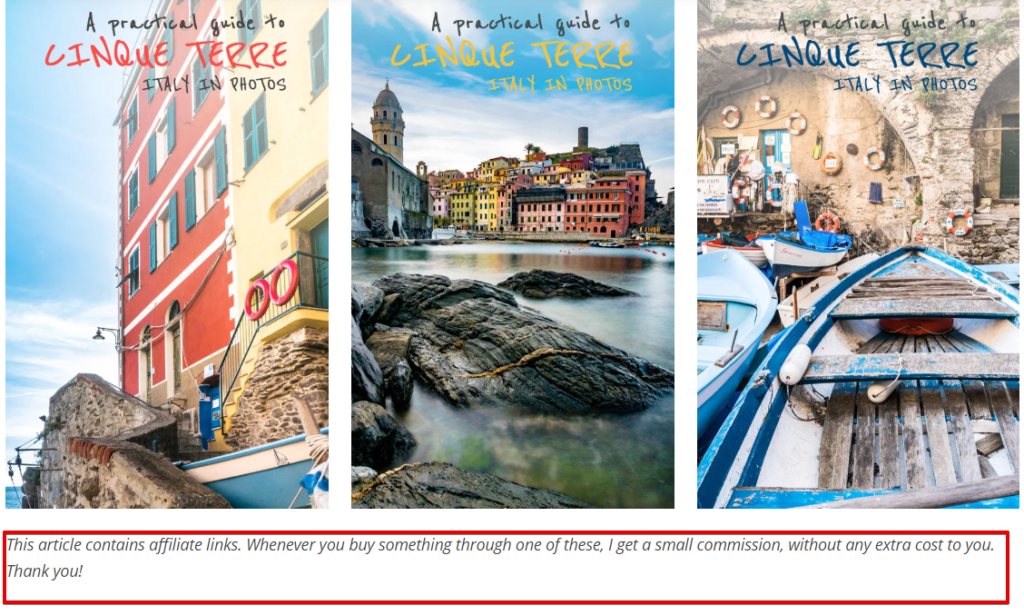
Lili’s travel plans is an inspiring blog about Lili’s life on the road. In her blog, Lili shares the stories behind the places she visits and also some affiliate links.
Whenever she promotes an affiliate link in the post, the blogger places a short in-content disclaimer at the bottom of her posts. Though the place of the disclaimer doesn’t fully comply with the guidelines of the FTC, it’s still transparent and explains the nature of her paid relationships. In her disclaimer, the blogger also reassures her audience that her affiliate relationships will not result in any additional cost for them.
Dan Flying Solo
Dan is obsessed with travel and quit his well-paying job in 2014. Since then he has been roaming the world and has become a professional blogger. Dan makes a living by telling people about his adventure stories in his blog and, also, by promoting affiliate products. The blogger strives to be absolutely transparent about his affiliate relationships with the readers.
So, he explains his principles of running affiliate business on the Cookie, Privacy, and Disclaimer Policy page.
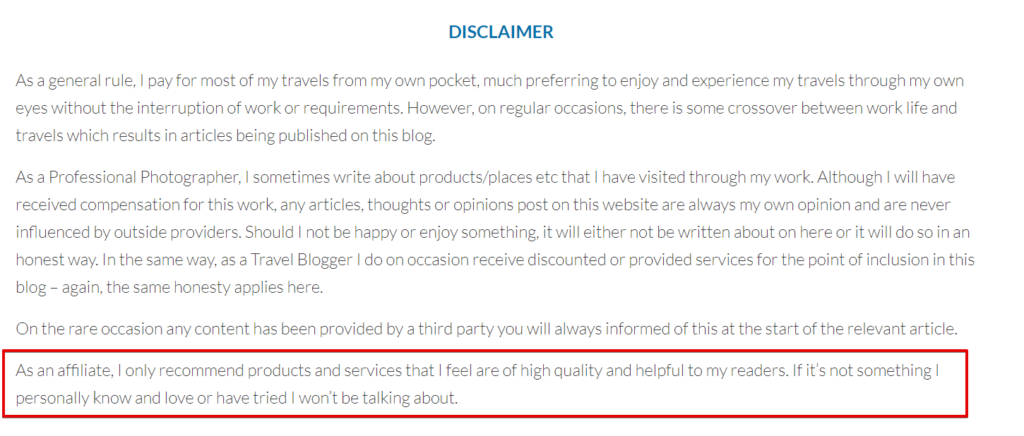
In addition, Dan places a disclaimer at the top of his posts as well as in the videos.
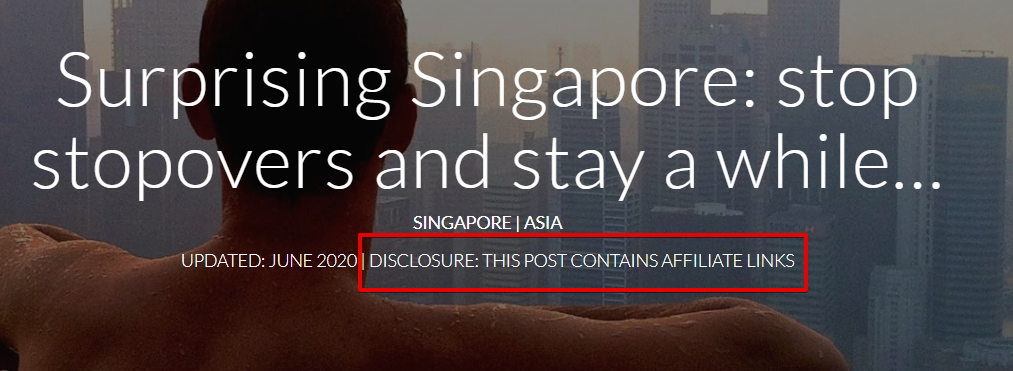
A Broken Backpack
Melissa Giroux is the creator of the blog called A Broken Backpack, an experienced traveler and a digital nomad. In her blog, she shares hands-on tips helping people to stay on the road longer and switch to the nomad lifestyle.
Mel uses affiliate marketing and advertising to monetize her blog and makes it crystal-clear to her readers with the help of affiliate disclaimers. There are several places on her website where you can find them.
Firstly, she explains the nature of the affiliate relationships she is involved in on the Disclaimer and Privacy Policy page.

Secondly, she places the disclaimer in the footer of her website.
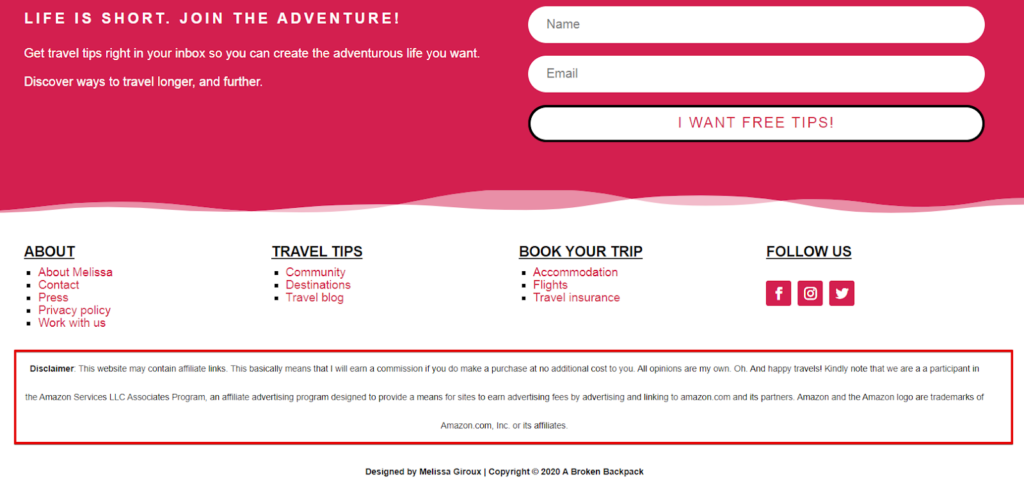
And last but not least, the blogger reveals her affiliate relationships at the bottom of most of her posts.

TravelBreak
This travel blog is another great example of affiliate marketing disclosure on a travel-related blog. The disclaimer is placed on the Disclaimer and Terms page and is concise, straightforward, and easy-to-understand.

Uncornered Market
Uncornered Market is a community of travelers who live by the motto: “Driven by Curiosity, Guided by Respect.” They also demonstrate respect to the audience by making their affiliate relationships obvious. For this, the bloggers place affiliate disclosures in several places on their website.
Firstly, on the Disclosure Policy page, they make it crystal clear that they get a commission if the readers make a purchase through their affiliate links.
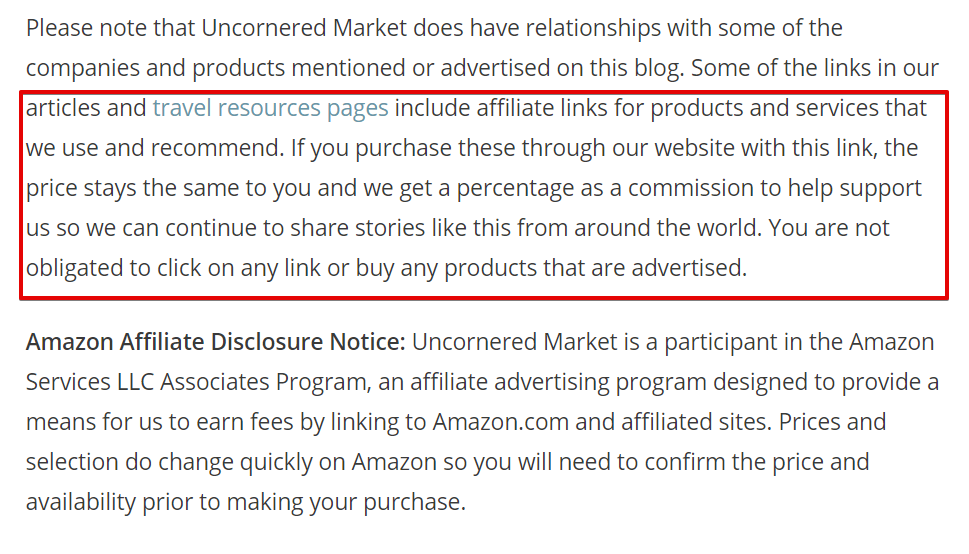
In addition, they place a short disclosure with a link to their Disclosure Policy page before every post to make readers aware of the affiliate relationships they are in.
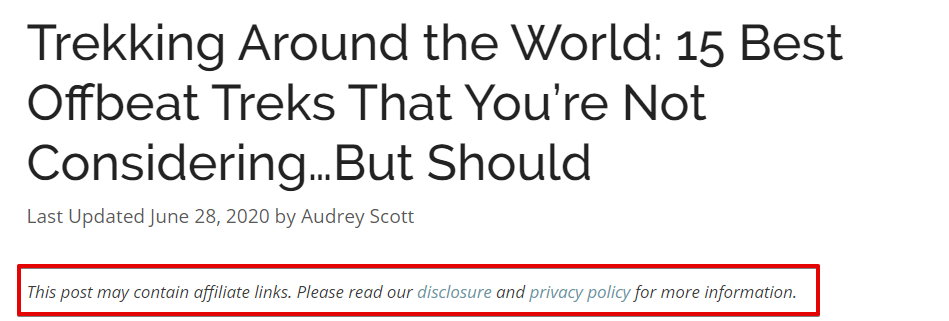
Atlas and Boots
Atlas & Boots is an outdoor travel blog with over 250,000 monthly readers. Its founders use the blog to put their passion for travel into words and generate income from it.
They also heed the FTC regulations and disclose affiliate links in several places on their website.
They explain the nature of their affiliate relationships on the Privacy Policy page.

Similar to the authors of Uncornered Market, they put a short disclaimer linking to the Privacy Policy Page before posts containing affiliate links.
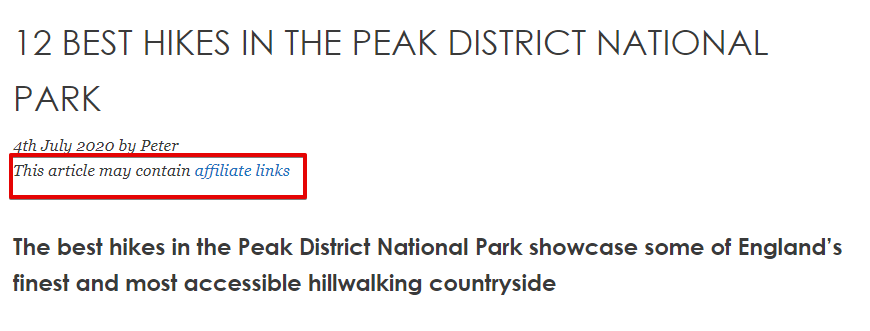
Wandering Earl
Derek, an experienced blogger and the founder of the Wandering Earl blog, also makes it obvious to readers that he may earn a commission for the purchases they make through affiliate links on his website.
There are several places where you can find affiliate disclaimers on this blog. A short affiliate disclaimer is embedded in the footer of the website.
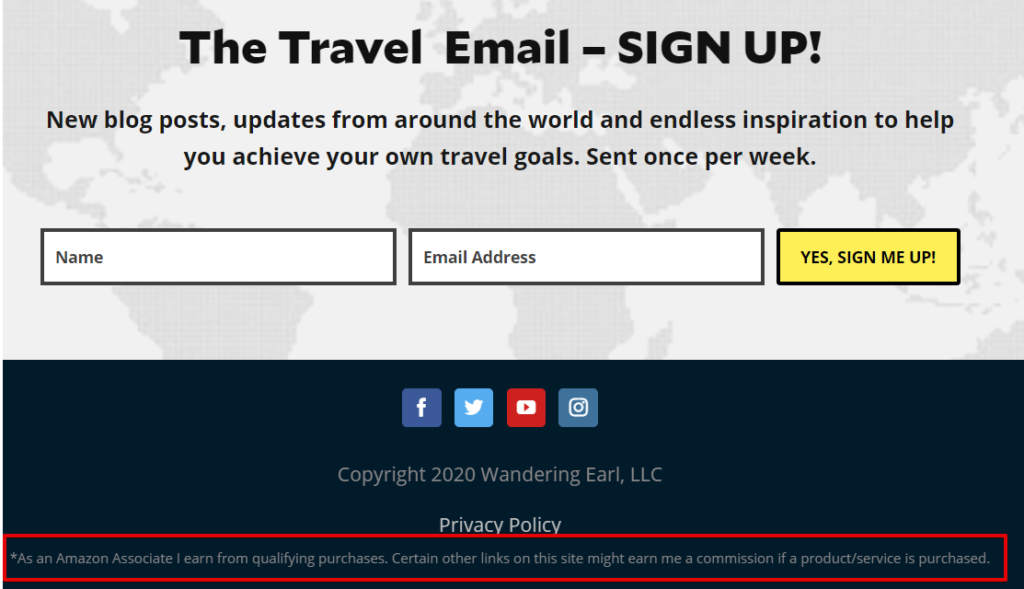
Also, Derek places disclaimers after posts containing affiliate links.

Nomadic Matt
Matt, the founder of the Nomadic Matt website and a New York Times best-selling author, runs his blog to help his audience answer travel-related questions and share valuable travel tips.
Matt also monetizes his travel expertise with affiliate marketing which he discloses on the Privacy Policy page of his website.

Besides, he places a hard-to-miss affiliate disclosure before or after posts containing affiliate links.
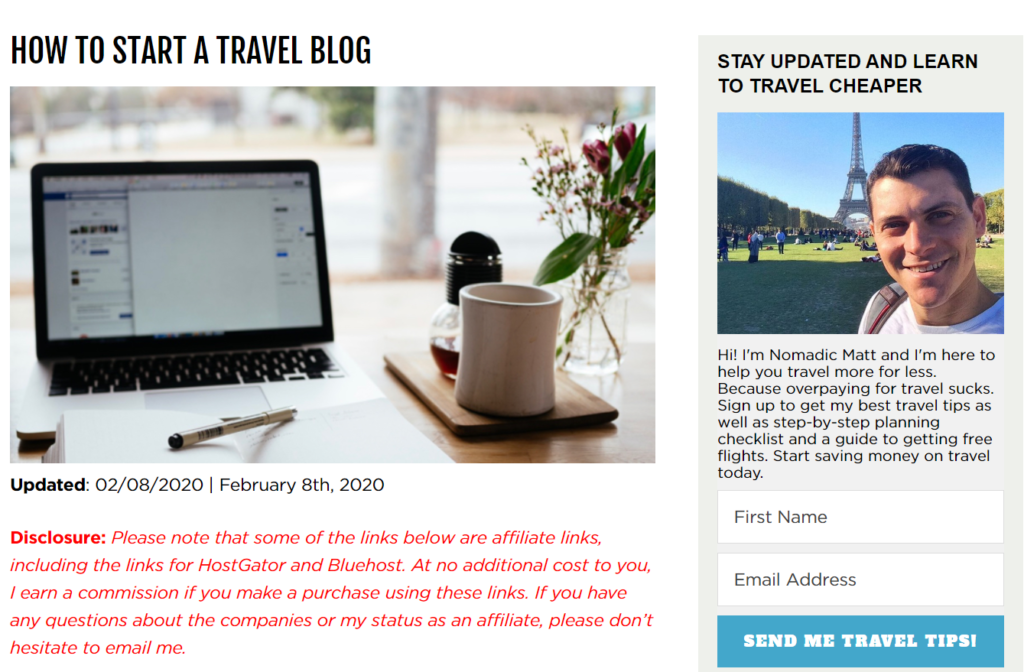

Anywhere We Roam
Anywhere We Roam is a travel blog by Mark and Paul who are living a life of adventure and sharing their off-the-beaten-path experiences with readers.
They include an in-content affiliate disclaimer in every post containing affiliate links. In the disclaimer, the bloggers also thank their readers for their support.
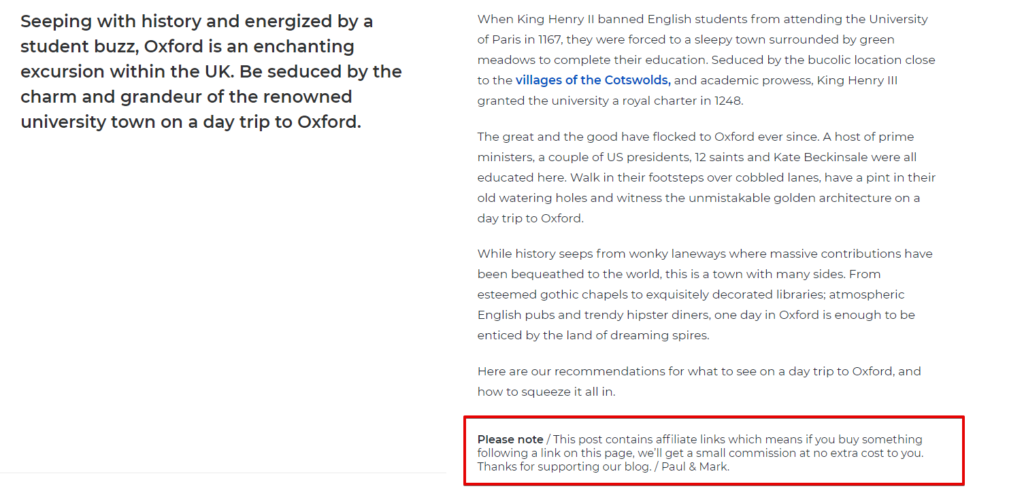
How to Write Affiliate Links Disclosure for Your Blog
To sum it all up, if you want to do affiliate marketing properly and build trust with your audience, disclosing affiliate links is a must. So, follow the hands-on tips we’ve shared with you and make your affiliate disclaimers hard-to-miss and easy-to-understand. But bear in mind that to win big as an affiliate, there are other important things to do such as creating top-notch content, tracking affiliate links, and experimenting with programs and tools.





